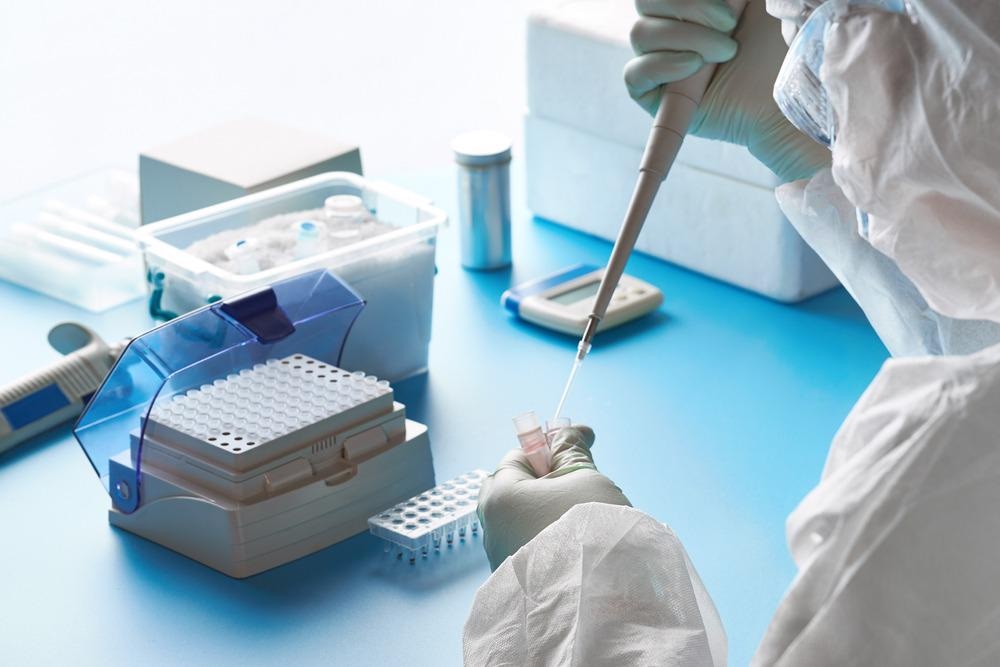With COVID-19 persisting despite our efforts, PCR has become a commonplace acronym, most often associated with reliable testing. However, the meaning of PCR is lost on many of those who use this abbreviation.

Image Credit: Prostock-studio/Shutterstock.com
In laymen’s terms, Polymerase chain reaction (PCR), is a lab procedure that is used to convert one small fragment of DNA or RNA into several fragments: in an exponential fashion. To elucidate each segment of the abbreviation, polymerase is an enzyme that generates polymers of another molecule, while a “chain reaction” is an exponential reaction that propagates rapidly.
How PCR is Most Often Used
Since its conception in 1983, PCR has proven indispensable in fields like genetic research, criminal investigation, and diagnostics. Though PCR has a myriad of different uses, people most often associate it with diagnosing viral infections. First, viral DNA is collected from the host; the medium used most often is blood or saliva. When this DNA is amplified using PCR, enough is generated so that the type of virus and its viral properties become known.
These PCR tests hold the most veracity when it comes to viral detection and are far more reliable than antigen tests. The WHO, as well as most clinically trained professionals, will attest to this. If biotic impurities and contaminations were to enter the solution, these entities would also be amplified. Therefore, the technique itself must be scrupulously done in a sterile environment.
Ingredients Required for PCR
If one were to make a shopping list of essential reagents used for PCR, the key components would be polymerase, primers (forward and reverse), template DNA, and nucleotides (dNTPs). Supplemental reagents that may aid in the yield and quality of the product would be reaction buffer, high GC enhancer (assuming the template of choice is rich in guanine and cytosine residues), and nuclease-free water. All ingredients are typically introduced to a microcentrifuge tube, resulting in a homogenous solution. Only after is the reaction subjected to PCR, but what do these reagents accomplish, and how?
Firstly, the primers, which are truncated segments of DNA (roughly 15-25 nucleotides long), will attach themselves to opposite strands of the template DNA. The forward primer will propagate nucleotides on one strand, while the reverse primer will add to the other. These primers are the point of origin for nucleotide binding, and the specific primer sequence will determine what region of DNA is replicated.
Thermus Aquaticus (TAQ) polymerase is a specific polymerase enzyme that is derived from heat-resistant bacteria, ideal for the high temperatures implemented in PCR. The role of TAQ Polymerase is to add the free dNTPs (guanine, adenine, cytosine, and thymine) to the 3’ end of the deoxyribose (on the third carbon).
These reactions all occur in an aqueous solution, incorporated with a buffer that makes the chemical medium more appropriate for the polymerase to add. Either the Tris-HCL or potassium ions (K+) from KCl that makes up the buffer will stabilize the DNA and encourage primer annealing. This makes sense, given that DNA itself is acidic.

Image Credit: anyaivanova/Shutterstock.com
The PCR Cycle
Many PCR instrument models exist on the market today, such as the Bio-Rad T100 Thermal Cycler, Qiagen’s QIAstat-Dx, etc. Their common purpose is to generate a warming cycle that drives replication. The steps that make up this warming cycle are denaturation, annealing, and extension.
Firstly, denaturation will separate the two strands of DNA from the double helix by raising the temperature to 95-98 degrees Celsius. The temperature one should use is dependent on the nature of the DNA; too cold and the strands will not separate, too warm and the DNA will decompose. Once denaturation is accomplished annealing will follow, which can also vary between 55-65 degrees Celsius.
The annealing temperature will vary the most and is dependent on the length of the oligonucleotide primers, and how GC (guanine + cytosine) rich the template is. Incorporating the correct annealing temperature critical for the primers to bind to the correct target sequence. The more nitrogenous bases a primer has, and the higher its GC content, the higher the annealing temperature will be. Laboratories will often incorporate the help of Tm calculators such as the “New England Biolabs Tm Calculator” to calculate annealing temperature.
The extension then follows. The temperature implemented in the extension cycle is usually 72 degrees Celsius and is dependent on the DNA polymerase that is being used. Here, each complementary strand of DNA will separate and bind to the free nucleotides found in the solution. This will result in two identical double-stranded DNA products.
Other PCR Applications
The long list of PCR applications that exclude testing is lost on the general public, though its utility has provided staggering progress in the fields of genetics and genomics. By using sequence-tagged sites, PCR can be used to indicate genome segments in a particular clone. This is done by amplifying a template (200-500 base pairs) and will recognize DNA sequences on a known genome map, serving as markers for genetic mapping in a chromosome. This was a key facet of the human genome project and is still used today
Another service that PCR provides can be found in site-directed mutagenesis. This is where PCR is implemented to replicate mutant plasmids, ensuring target transcripts for later transformations. Site-directed mutagenesis coupled with PCR can create designer mutant genes, which lead to designer protein structures. By creating these designer proteins, advancements have been made in the fields of medicine and biotechnology.
Sources:
- Tragoonrung S, Kanazin V, Hayes PM, Blake TK. Sequence-tagged-site-facilitated PCR for barley genome mapping. (1992) Theory Appl Genet. Sep;84(7-8):1002-8
- Garibyan, L., & Avashia, N. (2013). Polymerase chain reaction. The Journal of investigative dermatology, 133(3), 1–4
- Venta PJ, Brouillette JA, Yuzbasiyan-Gurkan V, Brewer GJ. (1996) Gene-specific universal mammalian sequence-tagged sites: application to the canine genome. Biochem Genet. Aug;34(7-8):321-41
- Bhagya CH, Wijesundera Sulochana WS, Hemamali NP. (2013) Polymerase chain reaction optimization for amplification of Guanine-Cytosine rich templates using buccal cell DNA. Indian J Hum Genet. 2013 Jan;19(1):78-83
- Ho SN, Hunt HD, Horton RM, Pullen JK, Pease LR. Site-directed mutagenesis by overlap extension using the polymerase chain reaction. (1989) Gene; 77(1):51-9.
Last Updated: Feb 24, 2022